Thermal cameras offer significant benefits for precision farming. They detect infrared radiation, revealing essential information about crop health, soil conditions, and irrigation needs. You'll identify plant stress, nutrient deficiencies, and pest infestations before visible symptoms appear. These cameras optimize water usage by detecting areas of water stress and irrigation system issues. They also monitor soil temperature, aiding in planting decisions and soil management. For livestock, thermal imaging helps detect health issues and monitor breeding cycles. With their ability to survey large areas quickly, thermal cameras enhance decision-making and resource management in agriculture. Exploring their full potential can revolutionize your farming practices.
Understanding Thermal Imaging in Agriculture

Thermal imaging, a powerful tool in modern agriculture, allows farmers to see beyond the visible spectrum. This technology detects infrared radiation emitted by objects, creating visual representations of temperature variations across fields and crops. You'll find that thermal cameras can capture detailed heat signatures, revealing essential information about plant health, soil conditions, and irrigation needs.
In agriculture, thermal imaging works by measuring the temperature differences between healthy and stressed plants. Healthy vegetation typically appears cooler due to transpiration, while stressed plants show up as warmer areas. You can use this data to identify issues like water stress, pest infestations, or nutrient deficiencies before they become visible to the naked eye.
Thermal cameras also help you assess soil moisture levels and irrigation efficiency. By detecting temperature variations in the soil, you can pinpoint areas that are too dry or oversaturated. This information enables you to optimize water usage and prevent crop damage.
Additionally, thermal imaging can assist in monitoring livestock health and identifying potential disease outbreaks by detecting abnormal body temperatures in animals.
Crop Health Assessment

Thermal cameras can revolutionize your crop health assessment by detecting plant stress before visible symptoms appear.
You'll be able to identify areas of your field where plants are struggling due to water stress, pest infestations, or disease outbreaks.
These cameras also help you pinpoint nutrient deficiencies by revealing temperature variations in leaves, allowing for targeted fertilizer application and improved overall crop management.
Detecting Plant Stress
Within the domain of crop health assessment, thermal cameras shine as powerful tools for detecting plant stress.
These advanced devices allow you to identify issues in your crops before they become visible to the naked eye. By measuring the temperature variations across your fields, you'll spot areas where plants are struggling due to various stressors.
Thermal imaging helps you detect:
- Water stress: Plants under water stress will have higher leaf temperatures
- Nutrient deficiencies: Certain deficiencies can cause temperature anomalies
- Pest infestations: Damaged areas may show different thermal signatures
- Disease outbreaks: Infected plants often exhibit altered heat patterns
With this information, you can take swift action to address problems before they spread or cause significant yield losses.
You'll be able to target your interventions precisely, applying water, nutrients, or pest control measures only where they're needed. This not only saves resources but also minimizes environmental impact.
Identifying Nutrient Deficiencies
In the domain of crop health assessment, thermal cameras offer a powerful tool for identifying nutrient deficiencies. These advanced devices can detect subtle temperature variations in plants, which often indicate specific nutrient imbalances. You'll find that different deficiencies cause distinct thermal patterns, allowing you to pinpoint problems accurately.
For instance, nitrogen deficiency typically leads to lower leaf temperatures, while potassium-deficient plants show higher thermal readings. By using thermal imaging, you can spot these issues before they become visible to the naked eye, giving you a significant head start in addressing the problem.
You'll also appreciate the efficiency of thermal cameras in surveying large areas quickly. Instead of manually inspecting each plant, you can cover entire fields in a fraction of the time. This speed enables you to respond promptly to nutrient deficiencies, potentially saving crops and improving yields.
Moreover, thermal imaging helps you create precise nutrient management plans. By identifying specific areas of deficiency, you can apply fertilizers and amendments exactly where they're needed, reducing waste and minimizing environmental impact. This targeted approach not only saves you money but also promotes more sustainable farming practices.
Water Stress Detection

One of the most essential applications of thermal cameras in precision farming is water stress detection. You can use these devices to identify areas of your crops that aren't receiving adequate water, allowing for targeted irrigation and resource conservation.
Thermal imaging detects temperature variations in plants, as water-stressed crops have higher surface temperatures due to reduced transpiration.
By employing thermal cameras for water stress detection, you'll:
- Optimize irrigation scheduling
- Reduce water waste and costs
- Prevent crop yield losses
- Improve overall plant health
You can mount thermal cameras on drones or tractors to survey large areas quickly and efficiently. The data collected helps you create detailed maps of your fields, highlighting zones that require immediate attention.
This information enables you to make informed decisions about water management, adjusting irrigation systems to deliver water where it's needed most.
Early detection of water stress is vital for maintaining crop health and maximizing yields. By incorporating thermal imaging into your precision farming practices, you're equipping yourself with a powerful tool to manage water resources effectively and guarantee the success of your agricultural operations.
Pest and Disease Identification
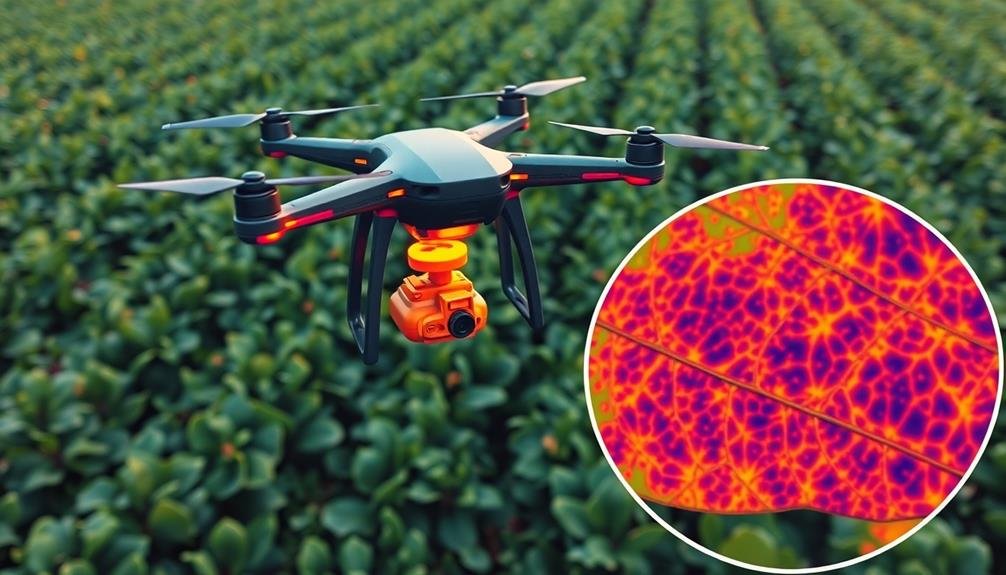
Thermal cameras aren't just useful for water management; they're also powerful tools for pest and disease identification in precision farming. These devices can detect subtle temperature variations in crops, which often indicate the presence of pests or diseases before visible symptoms appear.
You'll find that many plant pathogens and insect infestations cause changes in a plant's transpiration rate or metabolism, affecting its surface temperature. By scanning your fields with thermal cameras, you can spot these temperature anomalies early, allowing for targeted interventions and reducing the need for broad-spectrum pesticide applications.
Here's a quick overview of how thermal imaging helps with common crop issues:
| Issue | Temperature Change | Detection Timeframe |
|---|---|---|
| Fungal Infections | Increased | 1-3 days before visible symptoms |
| Bacterial Diseases | Increased | 2-4 days before visible symptoms |
| Insect Infestations | Varied | Up to a week before visible damage |
| Viral Infections | Decreased | 3-5 days before visible symptoms |
| Root Rot | Increased | 1-2 weeks before visible wilting |
Irrigation Management Optimization
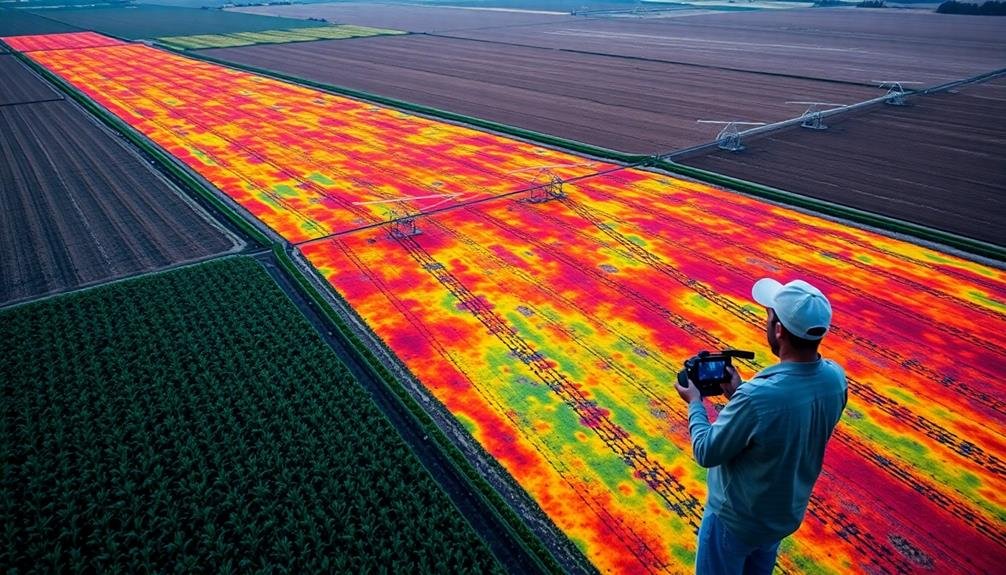
Several aspects of irrigation management can be optimized using thermal cameras, making them invaluable tools for precision farming.
You'll find that these devices can detect temperature variations across your fields, helping you identify areas that need more or less water. By using thermal imaging, you're able to assess soil moisture levels and plant stress, allowing for precise irrigation scheduling and application.
Thermal cameras enable you to:
- Detect dry spots or areas of overwatering
- Identify irrigation system leaks or blockages
- Monitor crop water stress in real-time
- Optimize water usage and reduce waste
You can use the data collected from thermal imaging to create detailed irrigation maps, ensuring that each area of your field receives the right amount of water.
This targeted approach not only conserves water but also promotes healthier crop growth and higher yields. By integrating thermal camera technology into your irrigation management strategy, you'll be able to make data-driven decisions that improve overall farm efficiency.
You'll save time, reduce costs, and minimize environmental impact while maximizing your crop productivity through precise water management.
Soil Temperature Monitoring
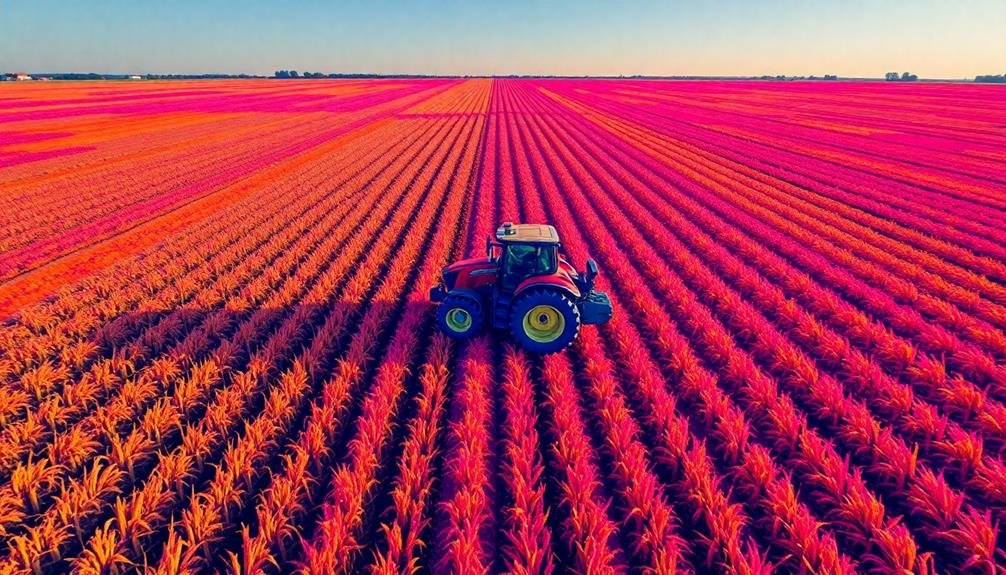
Beyond managing water resources, thermal cameras play a key role in monitoring soil temperature, another critical aspect of precision farming. You'll find that these cameras can detect subtle temperature variations across your fields, providing valuable insights into soil conditions.
By using thermal imaging, you can identify areas where soil temperatures are too high or too low for ideal plant growth. This information allows you to make informed decisions about planting times, seed selection, and soil amendments. You'll be able to pinpoint cold spots that may require additional attention or warmth, ensuring uniform germination and growth across your fields.
Thermal cameras also help you track the effectiveness of your soil management practices. You can observe how different tillage methods, cover crops, or mulching techniques affect soil temperature retention. This data enables you to fine-tune your strategies for maintaining perfect soil conditions throughout the growing season.
Moreover, you'll be able to detect potential issues like soil compaction or poor drainage, which can impact soil temperature and overall plant health. By addressing these problems promptly, you'll enhance your crop yields and resource efficiency.
Harvest Timing and Planning
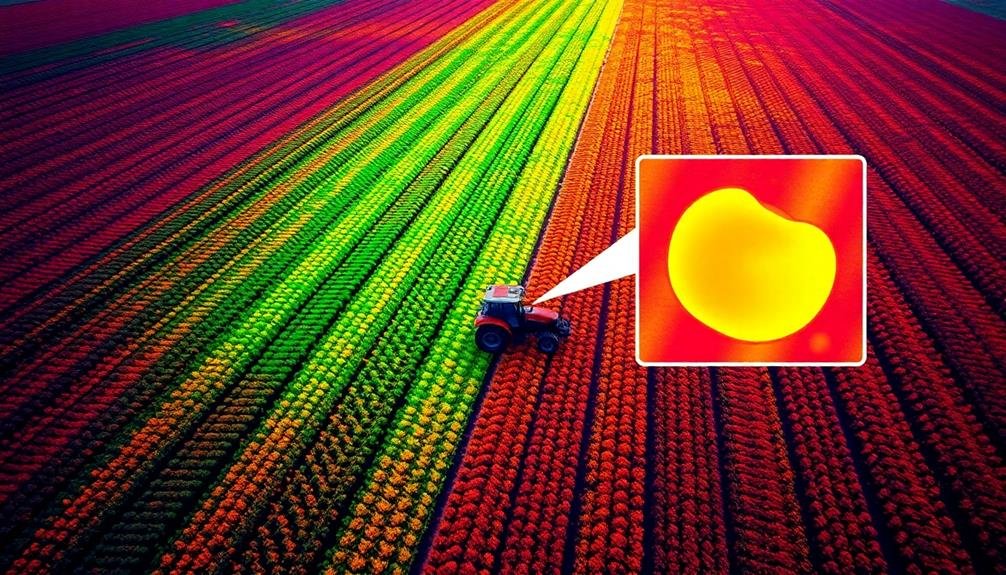
When it comes to harvest timing and planning, thermal cameras can make all the difference. These advanced tools allow you to monitor crop maturity and determine the ideal time for harvest.
By detecting subtle temperature variations across your fields, you'll gain valuable insights into crop readiness that aren't visible to the naked eye.
Thermal imaging helps you identify areas where crops are maturing faster or slower than others, enabling you to plan your harvest more efficiently. You'll be able to prioritize which sections of your field to harvest first, minimizing losses due to over-ripening or weather damage.
This technology also assists in planning equipment logistics and labor needs, as you'll have a clearer picture of when and where harvesting activities should take place.
Here are some key benefits of using thermal cameras for harvest timing and planning:
- Precise determination of crop maturity levels
- Early detection of potential harvesting issues
- Enhancement of harvest schedules for maximum yield
- Improved resource allocation and labor management
Livestock Monitoring and Management
Thermal cameras can revolutionize your livestock monitoring and management practices.
You'll be able to detect health issues and diseases earlier by identifying temperature anomalies in your animals. These advanced imaging tools also allow you to assess stress levels and monitor breeding cycles more effectively, leading to improved overall herd management.
Health and Disease Detection
Farmers and ranchers have a powerful ally in thermal cameras when it comes to monitoring livestock health and detecting diseases early. These devices can detect subtle temperature changes in animals, often indicating the onset of illness before visible symptoms appear. By identifying sick animals quickly, you can isolate them from the herd, preventing disease spread and reducing overall treatment costs.
Thermal imaging allows you to:
- Detect fever and inflammation in animals
- Identify mastitis in dairy cows before physical signs appear
- Spot respiratory issues by observing heat patterns in the lungs
- Monitor wound healing progress and potential infections
You'll find thermal cameras particularly useful for large-scale operations where individual animal observation is challenging. They enable you to scan entire herds efficiently, pinpointing animals that require closer examination.
This technology also helps in evaluating the effectiveness of treatments by tracking temperature changes over time. By incorporating thermal imaging into your regular health checks, you'll improve your farm's biosecurity measures and overall animal welfare.
It's a non-invasive method that reduces stress on animals while providing valuable health insights, ultimately leading to better productivity and profitability for your livestock operation.
Stress Level Assessment
Three key stress indicators in livestock can be effectively monitored using thermal imaging technology: body temperature, respiration rate, and blood flow patterns. By detecting subtle changes in these factors, you'll be able to identify stressed animals before visible symptoms appear. This early detection allows you to intervene promptly, preventing further health complications and maintaining ideal productivity.
You'll find thermal cameras particularly useful for evaluating heat stress in cattle, which can greatly impact milk production and fertility. By scanning your herd, you'll quickly identify animals with elevated body temperatures, enabling targeted cooling interventions.
Similarly, you can detect cold stress in newborn calves or lambs, ensuring timely care to prevent hypothermia.
Thermal imaging also helps you analyze the effectiveness of your stress management strategies. You'll be able to compare thermal profiles before and after implementing cooling systems, adjusting feed rations, or modifying housing conditions.
This data-driven approach allows you to fine-tune your management practices, enhancing animal welfare and farm efficiency. By incorporating thermal cameras into your routine stress level evaluations, you'll enhance your ability to maintain a healthy, productive livestock population.
Breeding Cycle Monitoring
Precision in breeding cycle management takes a leap forward with thermal imaging technology.
You'll find that thermal cameras offer invaluable insights into livestock's reproductive status, allowing for more accurate timing of breeding activities. By detecting subtle temperature changes associated with estrus, you can pinpoint the ideal mating period, increasing successful pregnancies and overall herd productivity.
Thermal imaging also helps you monitor pregnancy progression. You'll be able to identify potential complications early on, such as fetal distress or impending abortions, enabling timely interventions. This technology proves particularly useful for large-scale operations where individual animal observation is challenging.
Key benefits of using thermal cameras for breeding cycle monitoring include:
- Early detection of estrus, even in silent heat cases
- Improved timing of artificial insemination
- Non-invasive pregnancy confirmation
- Identification of potential reproductive health issues
Cost-Effectiveness of Thermal Drone Cameras
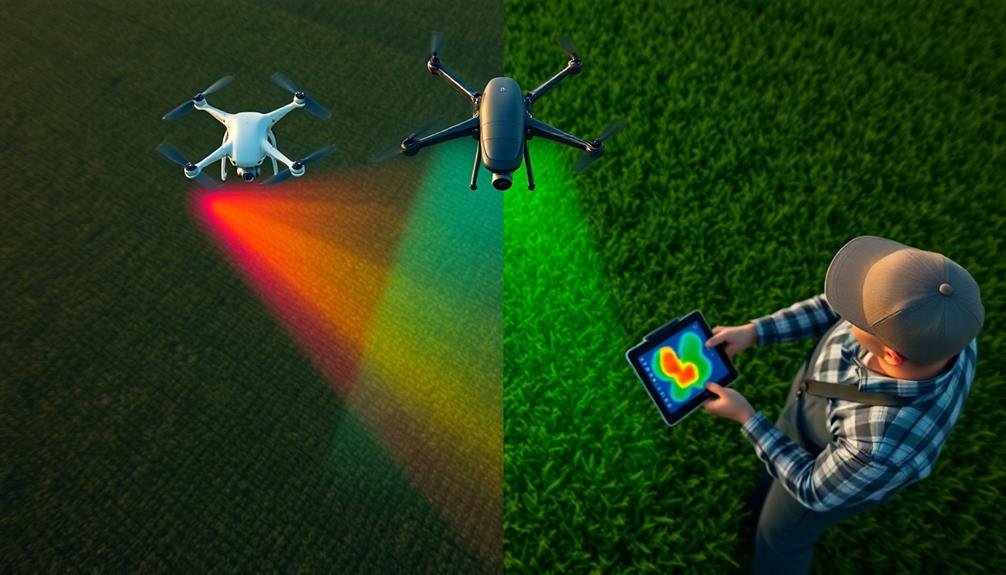
The initial investment in thermal drone cameras may seem steep, but their long-term benefits often outweigh the costs. You'll find that these devices can considerably reduce your overall expenses in precision farming. By identifying crop stress early, you're able to target interventions precisely, saving on water, fertilizer, and pesticides. This targeted approach not only cuts down on input costs but also helps maximize your yield potential.
You'll also save time and labor costs with thermal drone cameras. Instead of manually scouting large fields, you can quickly survey your entire farm from above. This efficiency allows you to cover more ground in less time, freeing up resources for other essential tasks.
Additionally, the data collected by these cameras can help you make informed decisions, potentially preventing costly crop failures.
When considering the cost-effectiveness, factor in the device's versatility. You can use thermal cameras for various applications beyond crop monitoring, such as equipment maintenance and livestock management.
This multipurpose functionality increases the overall value of your investment, making thermal drone cameras a cost-effective tool for modern precision farming operations.
Frequently Asked Questions
Can Thermal Cameras Detect Nutrient Deficiencies in Crops?
Yes, thermal cameras can help you detect nutrient deficiencies in crops. They'll show you temperature variations that often indicate stress from lack of nutrients. You'll see these issues before they're visible to the naked eye, allowing for early intervention.
How Often Should Thermal Imaging Surveys Be Conducted for Optimal Results?
You'll want to conduct thermal imaging surveys regularly, typically every 1-2 weeks during the growing season. However, you should increase frequency during critical growth stages or when you suspect stress. It's best to tailor the schedule to your specific crops.
Are Thermal Cameras Effective for Indoor or Greenhouse Farming?
Yes, thermal cameras are highly effective for indoor and greenhouse farming. You'll find they're great for monitoring plant health, detecting temperature variations, and identifying irrigation issues. They can help you optimize growing conditions and boost crop yields.
Can Thermal Imaging Help in Identifying Weed Infestations?
Yes, thermal imaging can help you identify weed infestations. You'll spot weeds easily as they often have different temperatures than crops. This technology allows you to target problem areas quickly and efficiently, improving your weed management strategies.
What Weather Conditions Are Ideal for Conducting Thermal Imaging Surveys?
You'll want clear, dry conditions for ideal thermal imaging surveys. Avoid rain, fog, or strong winds. Early morning or late afternoon are best, when temperature differences are more pronounced. Cloudy days can also yield good results.
In Summary
You've seen how thermal cameras revolutionize precision farming. They're invaluable tools for evaluating crop health, detecting water stress, and managing irrigation. You can spot pests and diseases early, monitor soil temperature, and optimize harvest timing. Don't forget their benefits for livestock management. While the initial investment might seem high, you'll find thermal drone cameras are cost-effective in the long run, improving yields and reducing resource waste. Embrace this technology to stay ahead in modern agriculture.

As educators and advocates for responsible drone use, we’re committed to sharing our knowledge and expertise with aspiring aerial photographers.
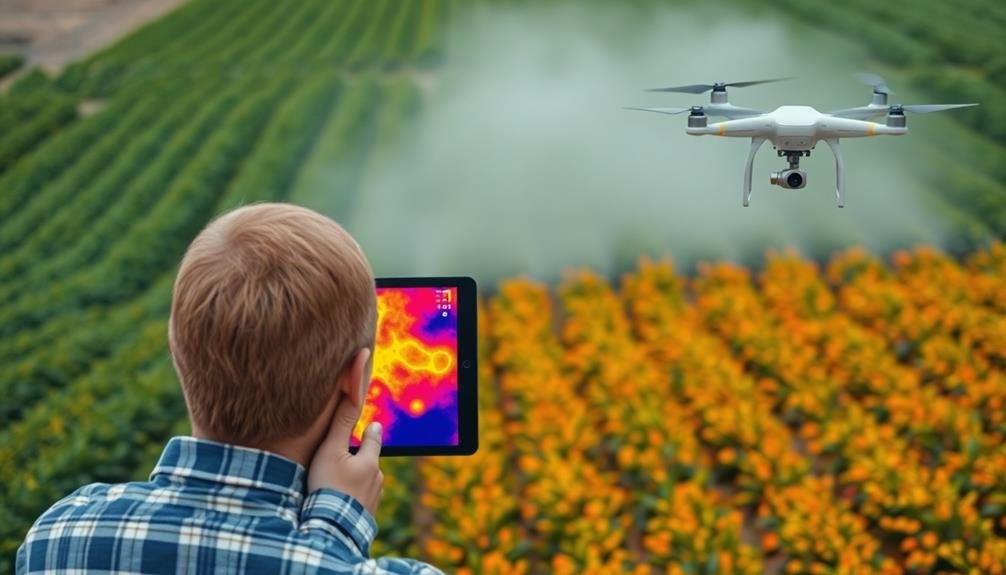



Leave a Reply